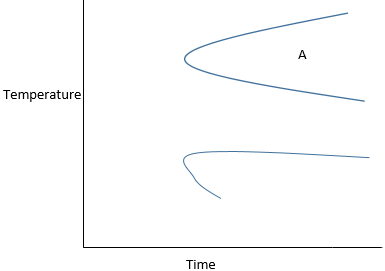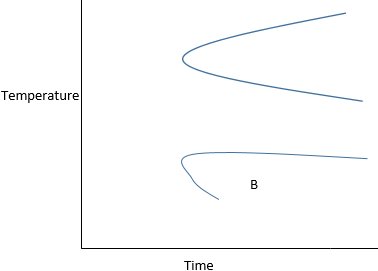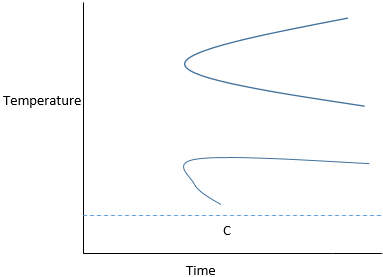This set of Mechanical Metallurgy Multiple Choice Questions & Answers (MCQs) focuses on “Strengthening Mechanisms – Strain Hardening – 1”.
1. Which of the following process does not produce the vacancy in the lattice?
a) Movement jog by dislocation intersection
b) Quenching near melting point temperature
c) Irradiation of metal with high energy particles
d) Grain growth
View Answer
Explanation: The Movement jog by dislocation intersection, quenching near melting point temperature, irradiation of metal with high energy particles all the three processes create a vacancy in the lattice. But the gain growth does not affect the concentration of vacancy.
2. The transformation of austenite to martensite is diffusionless.
a) True
b) False
View Answer
Explanation: The transformation of austenite to martensite is diffusionless, shear-type transformation in quenching the steel.
3. The martensitic transformation occurs only in iron and carbon system or alloys.
a) True
b) False
View Answer
Explanation: The martensitic transformation is predominant in steels, but this type of diffusionless transformation is observed in other metal alloys system also, Example – nickel-based alloys.
4. The habit plane is the plane which ________________
a) is parallel to the principal normal stress direction
b) is parallel to the principal shear stress direction
c) remains unaffected during transformation
d) has the maximum atomic density
View Answer
Explanation: During the martensitic transformation, shearing occurs along certain crystallographic planes, and the plane rotates during the transformation from FCC->BCT. But there are certain planes which are common in both the structure and are called habit planes.
5. As the carbon content of the steel increases, the hardness of steel __________ on quenching.
a) increases
b) decreases
c) remains constant
d) no relation
View Answer
Explanation: As the carbon concentration increase in steel, the martensite obtained after quenching will also be more hardened.
6. What does Region A represent in the following time-temperature transformation diagram (TTT)?

a) Pearlite
b) Bainite
c) Austenite
d) Martensite
View Answer
Explanation: The pearlite generally forms on slow cooling (So the change in temperature with time should be low). So, the slope of TTT curve will be the region where it can be subjected to slower cooling rates.
7. What does Region B represent in the following time-temperature transformation diagram (TTT)?

a) Pearlite
b) Bainite
c) Austenite
d) Martensite
View Answer
Explanation: The bainite forms rapid quenching and holding the sample at an intermediate temperature and then cooling. So, the region will be at the lower right part of the curve.
8. What does Region C represent in the following time-temperature transformation diagram (TTT)?

a) Pearlite
b) Bainite
c) Austenite
d) Martensite
View Answer
Explanation: The Martensite is formed by the rapid cooling of the sample without touching the pearlite or bainite nose, and bringing the sample below a critical temperature (martensite start temperature).
9. Which of the following is a thermo-mechanical treatment?
a) Quenching
b) Annealing
c) Ausforming
d) Cold working
View Answer
Explanation: The thermos-mechanical treatment involves heating and plastic deformation together in a single process. So in the ausforming the Austenite matrix is plastically deformed and then quenched to form high strength martensite.
10. In which crystal the strain hardening will be least?
a) BCC
b) FCC
c) BCT
d) HCP
View Answer
Explanation: The strain hardening occurs by the intersection of dislocation. In HCP, the slip occurs only on single planes, so chances of dislocation entanglement are low and strain hardening is also low.
11. In X-ray diffraction technique, the cold-worked sample is identified by _________
a) width of peak
b) intensity of the peak
c) position of peak
d) not possible to identify in XRD
View Answer
Explanation: If the cold worked sample is loaded in XRD and data is compared with a sample without cold of the same material; the characteristic difference between the two samples will that cold worked sample will have broader peaks compared to the standard sample.
12. Which of the following is the region of highest dislocation density?
a) Grain interior
b) Grain boundary
c) Cell interior
d) Cell wall
View Answer
Explanation: Boundaries of any lattice are formed by an array of dislocations. The grain boundary is a region separating two different grains. In cell structure, the cellular structure is formed in heavy deformation (cold working) when dislocation accumulates and arrange themselves to create a region of the cell wall. It has very high dislocation density.
13. During plastic deformation, the percentage of energy which is retained by lattice, in the form of lattice strain or other method is roughly equal to__________
a) 1%
b) 10%
c) 50%
d) 90%
View Answer
Explanation: Most of the energy supplied for plastic deformation goes into heat energy. Thus, as sample gets heated up, most of the energy is used in changing the shape of the material and around 10% is retained by lattice to increase the internal energy.
14. The amount of energy stored by the metal during deformation does not depend on ________
a) initial temperature
b) solute content
c) deformation type
d) heating method
View Answer
Explanation: The amount of energy stored in the sample depends upon the temperature at which deformation is carried out; at a lower temperature, more energy will be stored and vice versa. Solute content helps in retaining energy. Deformation type has a different impact on stored such as wire drawing, and tension will have different stored energy. But the method of heating has no significant effect on the amount of stored energy.
15. Rate of strain hardening is equal to ___________
a) the slope of the flow curve
b) the intercept of flow curve on the x-axis at the yield point
c) the intercept of flow curve in y-axis at the yield point
d) slope at maximum tensile stress
View Answer
Explanation: The strain hardening is the phenomena in which the required stress value increases with the increase in strain. So the slope of the flow curve will indicate how much the necessary stress values are increasing with the increase in strain.
Sanfoundry Global Education & Learning Series – Mechanical Metallurgy.
To practice all areas of Mechanical Metallurgy, here is complete set of 1000+ Multiple Choice Questions and Answers.
If you find a mistake in question / option / answer, kindly take a screenshot and email to [email protected]
- Practice Metallurgical Engineering MCQs
- Check Metallurgical Engineering Books
- Check Mechanical Metallurgy Books
- Apply for Metallurgical Engineering Internship
